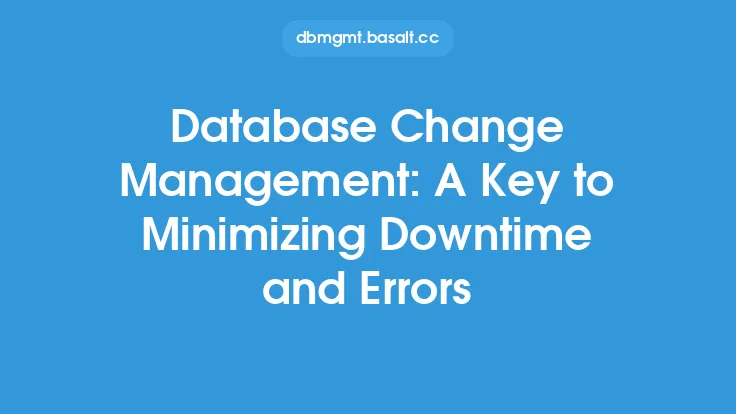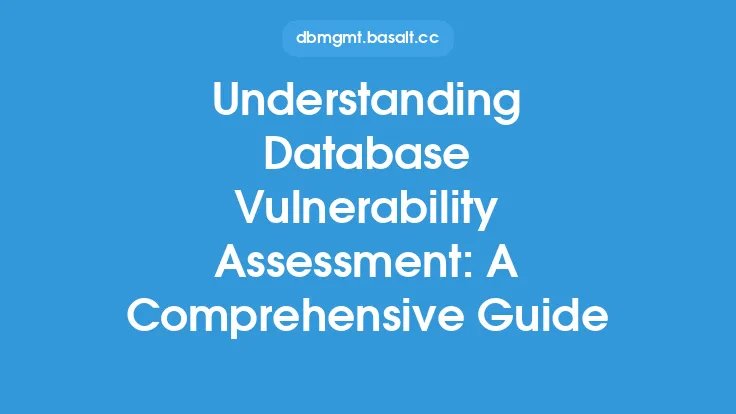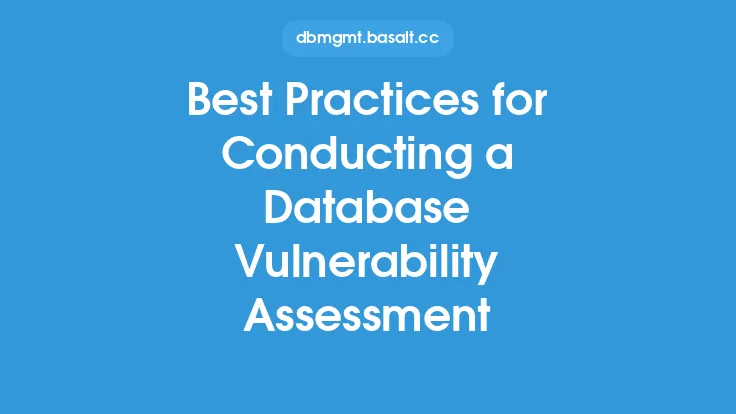Database security is a critical aspect of any organization's overall information security posture. With the increasing reliance on databases to store and manage sensitive data, the risk of data breaches and cyber attacks has become a major concern. One of the key measures to prevent data breaches is to conduct a thorough database vulnerability assessment. This process involves identifying, classifying, and prioritizing vulnerabilities in the database, as well as providing recommendations for remediation.
Introduction to Database Vulnerability Assessment
A database vulnerability assessment is a systematic process that evaluates the security posture of a database by identifying potential vulnerabilities and weaknesses. The assessment involves a comprehensive review of the database's configuration, architecture, and security controls to determine the likelihood and potential impact of a security breach. The goal of a database vulnerability assessment is to identify vulnerabilities that could be exploited by attackers to gain unauthorized access to sensitive data or disrupt database operations.
Types of Database Vulnerabilities
There are several types of database vulnerabilities that can be exploited by attackers. These include:
- Configuration vulnerabilities: These occur when the database is not properly configured, leaving it open to attack. Examples include weak passwords, outdated software, and misconfigured access controls.
- Design vulnerabilities: These occur when the database design is flawed, making it vulnerable to attack. Examples include poor data modeling, inadequate indexing, and insufficient data validation.
- Implementation vulnerabilities: These occur when the database is not properly implemented, leaving it open to attack. Examples include buffer overflows, SQL injection, and cross-site scripting (XSS).
- Operational vulnerabilities: These occur when the database is not properly maintained, leaving it open to attack. Examples include inadequate backup and recovery procedures, insufficient logging and monitoring, and poor incident response planning.
Database Vulnerability Assessment Methodology
A database vulnerability assessment typically involves the following steps:
- Planning and preparation: This involves defining the scope of the assessment, identifying the databases to be assessed, and gathering information about the database environment.
- Vulnerability scanning: This involves using automated tools to scan the database for potential vulnerabilities.
- Vulnerability analysis: This involves analyzing the results of the vulnerability scan to identify potential vulnerabilities and prioritize them based on risk.
- Penetration testing: This involves simulating an attack on the database to test its defenses and identify potential vulnerabilities.
- Reporting and remediation: This involves providing a report of the findings and recommendations for remediation.
Tools and Techniques for Database Vulnerability Assessment
There are several tools and techniques that can be used to conduct a database vulnerability assessment. These include:
- Vulnerability scanners: These are automated tools that scan the database for potential vulnerabilities.
- Penetration testing tools: These are tools that simulate an attack on the database to test its defenses.
- Configuration compliance tools: These are tools that check the database configuration against a set of predefined rules and regulations.
- Log analysis tools: These are tools that analyze database logs to identify potential security incidents.
Benefits of Database Vulnerability Assessment
Conducting a database vulnerability assessment can provide several benefits, including:
- Improved security posture: By identifying and remediating vulnerabilities, organizations can improve their overall security posture and reduce the risk of data breaches.
- Compliance with regulations: Many regulations, such as PCI-DSS and HIPAA, require organizations to conduct regular vulnerability assessments.
- Reduced risk of data breaches: By identifying and remediating vulnerabilities, organizations can reduce the risk of data breaches and protect sensitive data.
- Improved incident response: By identifying potential vulnerabilities, organizations can improve their incident response planning and reduce the impact of a security breach.
Challenges and Limitations of Database Vulnerability Assessment
Conducting a database vulnerability assessment can be challenging and time-consuming. Some of the challenges and limitations include:
- Complexity of database environments: Database environments can be complex and difficult to assess, especially in large organizations with multiple databases and systems.
- Limited resources: Conducting a database vulnerability assessment can require significant resources, including time, money, and personnel.
- Evolving threats: The threat landscape is constantly evolving, making it challenging to stay ahead of potential vulnerabilities and threats.
- False positives and false negatives: Vulnerability scanners and other tools can generate false positives and false negatives, which can be time-consuming to investigate and remediate.
Best Practices for Database Vulnerability Assessment
To get the most out of a database vulnerability assessment, organizations should follow best practices, including:
- Conducting regular assessments: Regular assessments can help identify vulnerabilities and weaknesses before they can be exploited.
- Using automated tools: Automated tools can help streamline the assessment process and reduce the risk of human error.
- Involving multiple stakeholders: Involving multiple stakeholders, including database administrators, security teams, and compliance officers, can help ensure that the assessment is comprehensive and effective.
- Prioritizing remediation: Prioritizing remediation based on risk can help ensure that the most critical vulnerabilities are addressed first.
- Continuously monitoring and improving: Continuously monitoring and improving the database security posture can help stay ahead of potential vulnerabilities and threats.





